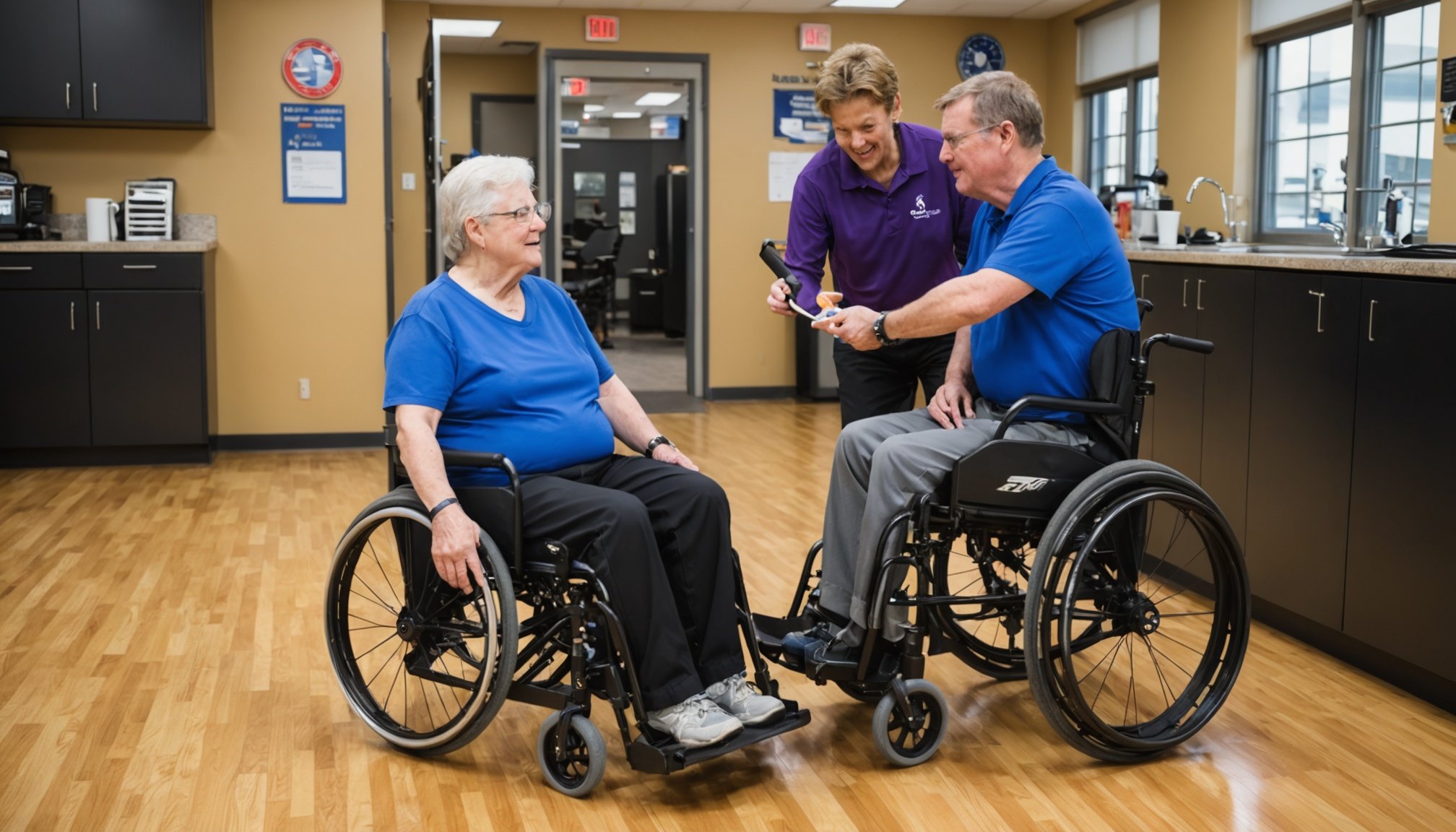Overview of Adaptive Equipment and Its Importance
Adaptive equipment serves as a crucial catalyst for enhancing independence among individuals with disabilities. Essentially, adaptive equipment refers to any device or system specifically designed to assist people in performing tasks that might otherwise be challenging, whether due to physical, sensory, or cognitive impairments.
Examples include wheelchairs, hearing aids, and specialised communication devices. These innovations play a vital role in empowering users, providing them with the tools to lead more self-sufficient lives. For instance, a motorised wheelchair can significantly enhance mobility for someone with limited physical movement, offering the freedom to navigate various environments independently.
Additional reading : Discover love: dating for people with disabilities
The importance of adaptive equipment cannot be overstated. It often means the difference between reliance on external support and the ability to perform daily functions solo. By mitigating the limitations imposed by certain disabilities, adaptive equipment helps bridge gaps, enabling individuals to engage more fully in work, social activities, and personal care.
A wide range of disabilities, from mobility challenges to hearing impairments, benefits from these devices. Tailored solutions, like voice-activated systems for those with motor control issues, exemplify how such equipment can be customised to accommodate specific needs, further enhancing its value and impact.
Topic to read : Mastering anxiety management: essential tools for inner peace
Types of Adaptive Equipment
Exploring adaptive equipment opens a world of possibilities for enhanced independence and function. Each type serves a distinct purpose tailored to individual needs.
Mobility Aids
Mobility aids are designed to support movement and reduce the risk of falls. Choices include wheelchairs and scooters, which provide independence and freedom of movement. More basic options are canes, walkers, and crutches, essential for stability and support.
Choosing the right mobility aid is crucial. It’s essential to consider the individual’s physical condition, environment, and specific needs. A lightweight manual wheelchair may be ideal for someone with upper body strength, while an electric scooter might suit someone requiring less physical exertion. Consulting healthcare professionals ensures a more informed decision.
Daily Living Aids
Daily living aids facilitate routine activities, significantly benefiting those with physical challenges. Tools for personal care and hygiene, such as adaptive toothbrushes, enhance daily self-care routines.
In the kitchen, gadgets for cooking and eating, like easy-grip utensils, promote independence. Home modifications such as grab bars and widened doorways increase accessibility and ease of movement.
Communication Aids
For communication, speech-generating devices and assistive technology enhance written interaction. These tools support social interactions, enabling more confident and effective communication. Through these aids, individuals engage more actively in their communities, increasing their quality of life.
Strategies for Effective Use of Adaptive Equipment
Incorporating adaptive equipment into daily life enhances functional independence—a crucial goal for many individuals. Begin with assessing personal needs and preferences. This crucial step determines which specific adaptive devices align best with individual requirements and lifestyle. Consider factors like the user’s physical abilities, daily challenges, and personal objectives.
Once you’ve made a selection, the next phase involves training and adjusting the equipment for optimum use. Instructional sessions can significantly impact a user’s ability to effectively operate adaptive equipment. Training facilitates a deeper understanding of device functionalities, ensuring users safely and confidently use the equipment. Adjustments, whether in height, reach, or settings, should be tailored to user needs to maximize comfort and efficiency.
Integrating adaptive equipment into daily routines can initially pose challenges. Professional guidance or routine planning can ease this transition. Gradual integration allows users to familiarize themselves with their equipment without feeling overwhelmed. In time, these devices transform from external aids into seamless parts of daily life, promoting autonomy and carefully-attuned usage strategies.
Following these practical tips not only augments the potential of adaptive devices but also empowers individuals, promoting a fulfilling lifestyle through enhanced independence.
Success Stories and Case Studies
Exploring success stories offers an optimistic lens through which the transformative power of adaptive equipment becomes evident. These real-life examples highlight the true impact on daily life.
Individual Case Studies
-
Personal stories unfold how adaptive technologies have unlocked increased independence for many users. One story, for instance, describes a young man with cerebral palsy who, through a specialized wheelchair, gained control over his mobility, leading to newfound confidence in his personal and social life.
-
Testimonials from users and caregivers abound, narrating honest experiences. A mother recounts how adaptive utensils allowed her son to eat independently, a step that not only fostered dignity but also alleviated daily challenges.
-
Analyzing various case studies provides insight into different disabilities addressed. Adaptive clothing for arthritis patients simplifies dressing, reducing pain and promoting ease. Such stories prove pivotal to understanding widespread benefits.
Professional Insights
Experts shed light on the significance of implementing effective strategies. Therapists and specialists recommend adaptive tools tailored to individual needs, endorsing their adoption based on substantial data indicating enhanced quality of life.
Reports support the benefits of adaptive equipment, with quantified results like improved self-esteem and daily functionality. Recommendations from these professionals further solidify the case for real-life applications of adaptive solutions, guiding individuals and caregivers in making informed decisions.
Resources for Obtaining Adaptive Equipment
Navigating the resources available for obtaining adaptive equipment can be challenging, but knowing where to look can ease the process significantly. Numerous government and non-profit organizations offer assistance tailored to individuals’ needs. For instance, programs like Social Services aid in accessing equipment funding, ensuring those eligible have the necessary supports in place.
A variety of funding options exist to help offset the financial burden of acquiring adaptive gear. Many users find it helpful to explore grants specific to their disability, or look into loan programs designed for purchasing equipment. These avenues provide financial support and flexibility, enabling individuals to obtain what they need at a lesser personal cost.
Moreover, online platforms have become invaluable as a resource guide for those seeking adaptive equipment. Websites dedicated to accessibility services enable users to buy or rent devices suitable for their unique requirements. These platforms often provide detailed information on the availability and specifications of equipment, allowing users to make more informed decisions.
By leveraging these resources, individuals can enhance their accessibility and improve their quality of life through appropriate adaptive technology. Understanding both funding options and accessible platforms is key to effectively navigating this landscape.
Visual Aids and Demonstrations
To fully grasp the potential of adaptive equipment, visual resources like videos and infographics are invaluable. These tools offer practical guidance, making complex concepts easier to understand.
Demonstration Videos
Demonstration videos play a crucial role in visual learning. By showcasing step-by-step guides for using specific equipment, these videos walk viewers through the process, ensuring clarity. Whether it’s setting up a high-tech gadget or adjusting basic tools, seeing the actions performed in real-time aids in comprehension. The importance of demonstrations becomes evident as they effectively convey equipment functionality, minimizing misunderstandings. Visual resources, particularly videos, provide a bridge between theoretical knowledge and real-world application, making them an essential component of any instructional guide.
Infographics and Visuals
Complementing videos are infographics and visuals, which condense key information into easily digestible formats. Diagrams illustrating equipment adjustments offer precise guidance, enabling users to make necessary modifications confidently. These visuals are not just instructional; they also motivate by visually representing success rates with adaptive equipment. A well-crafted infographic can highlight the effectiveness of a particular tool, reinforcing the concepts previously explained through text or video. By integrating these visual aids, understanding and applying practical guidance becomes significantly more accessible to all users.











